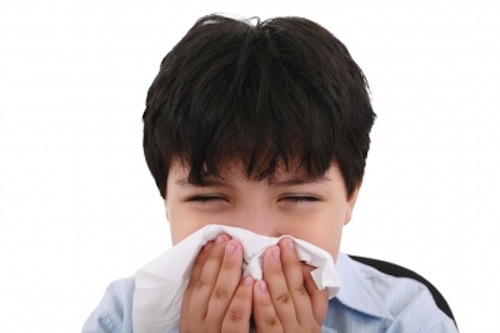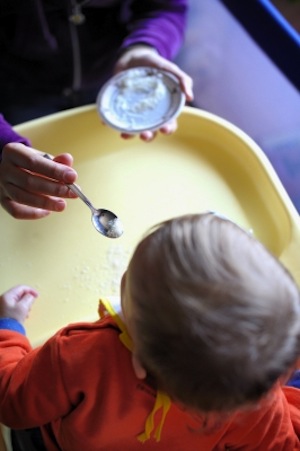Kids Nightmares: What Causes Them and How to Handle Them
Right around preschool-age, children start recognizing that nightmares are only dreams and cannot hurt them. This does not mean your child is any less scared. Your little one still needs your reassurance and understanding. Here’s a little bit of information about what may be causing his or her bad dreams and what you can do to help:
What causes nightmares?
1. An active imagination could be part of the reason your child wakes up in a cold sweat. Preschoolers use their imagination to make sense of the world around them. It can be used as their way of working through new information.
2. Children at this age have difficulty separating reality from make believe. They may believe in the Bogeyman as much as they believe in Santa Claus, making their nightmares that much more realistic.
3. Stress can trigger nightmares and stress is often a result of change at this age. Starting preschool is a huge change in preschoolers’ lives so a sense of worry and stress is only natural.
4. If something traumatic has recently happened in your child’s life, that could be the perpetrator. If there was a recent car accident or severe injury, nightmares could be a natural effect.
How can you help?
1. Help your child calm down as much as you can. Even though he or she is worked up, it’s important that they lose as little sleep as possible.
2. Try asking your kiddo what the dream was about and then use simple logic to explain that it was only a dream and, even though it was certainly scary, it wasn’t real and can’t hurt them.
3. When talking about the nightmare, keep it short and simple. You want to listen and reassure your little one, but you don’t want to spark their imagination and trigger any new nightmares.
4. Try soothing you child by rubbing his or her back, singing them a song or maybe just giving them a huge hug.
5. Prevent nightmares in the first place by sticking to a bedtime routine. Whether this includes reading a book, telling a story or singing a song, follow the same pattern nightly. Routine creates a sense of safety.
Sources:
-“Nightmares.” Kids Health.
-“Nightmares.” What to Expect.
-Photo courtesy of Jeanne Claire Maarbes/freedigitalphotos.net
Motor Skill Milestones
From only a few months old, babies will begin to develop motor skills. At first they’ll grab and giggle, but soon, they’ll begin to move their entire bodies.
Remember that each baby develops at his or her own pace so don’t panic if your child varies. However, if this is an ongoing trend you should ask your pediatrician about it just in case there are developmental delays.
Here are some key motor skill milestones to prepare for:
Rolling over
Around the same time that your baby is learning to sit on his or her own, they’ll learn to roll over. You’ll start to see your baby lift head and shoulders high, using arms in what looks like imitation pushups. Eventually, at as early as four months, your little one may be able to roll over from belly to back. But don’t worry if it takes another month or two to reverse the motion.
Crawling
Crawling typically starts to take place between six and 10 months. Likely signs that crawling is coming is if your baby starts repositioning his or herself from sitting up to hands and knees. You also may see some scooting, a sign of attempted movement. At first, babies may use the right leg and arm at the same time, but they’ll quickly learn that using the left arm with the right leg is much steadier and more efficient. Crawling gives babies an opportunity to explore the world around them.
Standing
After babies master crawling, they will begin to stand, not on their own at first, but while holding onto you or other objects for support. Babies are normally proficient standers by around nine months. Standing is an exciting sign because it’s the first step to walking.
Walking
Arguably one of the most exciting motor skill milestones, walking typically begins by holding onto objects and inching along. Most babies begin to walk on their own at around one year, but don’t begin to use more finely tuned motor skills, like walking backwards, until around 15 months.
Sources:
-“Developmental milestones: Rolling over.” Baby Center.
-“Baby physical and motor skills.” Baby Zone.
-“Baby Milestones.” Parenting.com.
-“Developmental milestones: Crawling.” Baby Center.
-“Milestone chart: 7-12 months.” Baby Center.
-Photo courtesy of photostock/freedigitalphotos.net
5 Finger Foods for Picky Eaters
Little ones can make meal times tough. Many children hit a phase where they refuse to eat what we put in front of them unless it’s a certain color, is one of two food items or contains 75% sugar. Sometimes there’s no rhyme or reason for these dietary decisions, but as parents, we know that they simply can’t continue. Growing kiddos need the right nutrients in order to stay healthy and strong. Check out these ideas for healthy finger foods that your picky eater will love:
Sweet potato chips
Cut a sweet potato or two into thin slices and place on a baking sheet. Drizzle the slices with olive oil and a tiny bit of salt. Bake for 20-25 minutes, or until golden brown and crispy.
Health benefits: Sweet potatoes are high in vitamins A, C and D, meaning they play a role in healthy teeth, bones, skin and a healthy immune system.
Frozen blueberries
Frozen blueberries are a fruity, tasty treat. Simply stick a bunch of them in the freezer or pick up some already frozen ones from the grocery store. Give them to your little one as a snack or first thing in the morning. To them, it’s like having ice cream for breakfast!
Heath benefits: Blueberries boost memory, key for those just starting out in their academic careers. They’re also high in fiber.
String cheese
String cheese is a fast, easy option that’s especially great for those who don’t get enough milk. Bonus: string cheese is easy to pack and an excellent grab-and-go food. Pick up skim versions if you’re worried about high fat content.
Health benefits: Cheese is a source of dairy for healthy bones, nails and teeth.
Hardboiled eggs
Hardboiled eggs are quick to make. Plus, they’re really inexpensive. Their unique texture may be enough to intrigue picky eaters, enticing them to eat this fun finger food.
Health benefits: Eggs are high in protein, B12 and iron, which is especially beneficial because the American Academy of Pediatrics says that 15% of children under three years old don’t get enough iron.
Grain-dusted strawberries
Chop up a few cups of strawberries and dust them with ground Cheereos. You can also do this with peaches, bananas, avocadoes or even tofu.
Health benefits: This tasty snack combines the health benefits of fruit and whole grain, incorporating nutrients like fiber, Vitamin C and potassium.
Sources:
-“9 Health Benefits of Sweet Potatoes.” Care 2 make a difference.
-Galland, Leo. “Surprising Benefits of Blueberries.” Huffington Post.
-Jacobsen, Maryann. “10 of the Best Finger Foods for Toddlers.” Raise Healthy Eaters.
-Giorgio, Katie. “Finger Foods for Toddlers.” Baby Zone
-Photo courtesy of David Castillo Dominici/freedigitalphotos.net
Your Toddler and TV: Why it’s Unhealthy
Children who increased the number of hours a week they spent watching TV between the ages of 2 and 4 may risk weight problems later on in life, a new study shows. After surveying the TV habits of more than 1,300 children, the Canadian study found that children whose weekly TV intake increased over the two-year time period had a higher-than-average waist circumference by age 10, and may have a greater chance of becoming overweight as adults.
The American Academy of Pediatrics recommends that children older than 2 not watch more than two hours of TV per day. The study found watching 18 hours of TV a week at 4.5 years of age would result in an extra 7.6 millimeters of waistline by age 10. Watching more than the recommended amount of TV may set up these youngsters for weight problems in high school and into adulthood.
Remaining sedentary throughout the day and eating nutrient-rich food is primarily to blame for the study’s results. The average amount of time spent in front of the TV was 8.8 hours per week at the start of the study (age 2). This increased to 14.8 hours per week by the end of the study two years later. Although XL toddler Halloween costumes may seem cute now, it may actually be an indication of a problem your child will battle later in life.
Changes You Can Make
If you’re a parent with a baby or a toddler, there are certain things you can do to limit their time spent in front of the TV and nip this potential health problem in the bud. First, permit your child to watch no more than two hours of TV per day. This includes movies. Encourage them go outside and be active; sign them up for peewee sports teams or just give them something to do in the great outdoors. Yes, it’s OK to make them do it – you are the parent, after all. Just like watching TV, playing sports and being outside enjoying Mother Nature are also habit-forming. An active lifestyle allows kids less time to be sedentary.
Remember to limit what they eat while watching TV, or eliminate this entirely. Give them nutritional supplements from companies such as Fortune-Hi Tech Marketing to help ensure they are getting the correct amount of vitamins, minerals and nutrients. Eating a box of cookies while watching TV is a fast track to cardiovascular problems later in life, as well as put them at risk for diabetes and other complications.
Make TV Time Count
If your toddler is going to watch TV for an extended period of time, make sure it’s educational, like “Sesame Street” or “Dora the Explorer” – at least they’ll be working out their minds, if not moving their bodies.
Serious Health Risks
Beyond the health risks associated with a child being overweight and possibly diabetic, there are other negative effects of watching so much TV. The toddler years are an important developmental phase and habits children learn during this time are often formed for the rest of their lives. Excessive TV may also lead to social problems, as TV is no substitute for real-world interaction with children their own age.
Setting limits on the amount of TV your child can watch is only part of the battle. Making healthy choices like using FHTM products and getting your children outside will also help your child want to be healthier and more active.
Lenny Houston A nutritionist and weight trainer, Lenny has also devoted much of his time to creating healthy and delicious recipes for people with food restrictions and allergies. He is currently working on a cookbook for the vegan, gluten free and diabetic.
7 of the Healthiest Foods to Feed Your Baby
Around four to six months, babies begin to develop the coordination to swallow foods. When moving from milk to solids, start slow with mushy foods. And remember that you can blend just about anything into an easy-to-swallow puree. Here are some healthy options for baby solids:
Baby cereal
Mix baby cereal with breast milk for an easy transition. This will start to get your child used to a thicker consistency, while still keeping things familiar. Plus, the extra grains are a great source of iron.
Avocados
The unsaturated fats in avocados are similar to those in breast milk so avocados make for another great transition food. Plus, they make great snacks on the go! They travel well because they can stay at room temperature.
Squash
High in vitamins A and C, cooked squash is simple to prepare and a baby favorite. It’s gooey texture is easy to eat and tough to choke on. Squash’s vitamin C will build a healthy immune system, help heal wounds and build scar tissue. The vitamin A will help with vision and maintain healthy skin, hair and teeth.
Apples
Apples are a tasty treat that little ones love. Just like squash, they’re high in vitamin C. Just peel the skin and chop the apples into tiny pieces to prevent choking.
Beans
Try feeding your child kidney or pinto beans. By about eight months old, you baby should be old enough to eat beans and they’re easy to prepare- just serve them right out of the can. Beans are a great source of protein and antioxidants.
Broccoli
Just because you didn’t like broccoli as a kid, doesn’t mean your baby won’t. Broccoli tends to get a bad rep taste-wise, but you baby doesn’t know that. Not only is it filled with calcium and fiber, but chilled broccoli can provide some relief for teething little ones.
Bananas
Gooey and easy to gum, bananas are a great choice for those just starting out on solid foods. You don’t even need teeth to eat them. Plus, bananas are a great source of potassium, key for healthy muscles. They could even help sooth the ache of growing muscles.
Sources:
-“The ten best foods for babies.” Baby Center
-“Vitamin C” and “Vitamin A” Medline Plus
-“Solid Foods.” Mayo Clinic.
-Photo courtesy of federico stevanin/freedigitalphotos.net
5 Child Napping Tips
Learn to recognize naptime.
Keep your eyes peeled for yawning, rubbing eyes and fussiness. When your baby is tired, he or she should sleep. Parenting.com recommends following this table for an estimated sleep guide:
| Age | Total Sleep | Nighttime Sleep | Naps |
| Newborn-2 months | 16-18 hours | 8-9 hours | 7-9 hours (3-5 naps) |
| 2-4 months | 14-16 hours | 9-10 hours | 4-5 hours (3 naps) |
| 4-6 months | 14-15 hours | 10 hours | 4-5 hours (2-3 naps) |
| 6-9 months | 14 hours | 10-11 hours | 3-4 hours (2 naps) |
| 9-12 months | 14 hours | 10-12 hours | 2-3 hours (2 naps) |
| 12-18 months | 13-14 hours | 11-12 hours | 2-3 hours (1-2 naps) |
| 18 months-2 years | 13-14 hours | 11 hours | 2 hours (1 nap) |
| 2-3 years | 12-14 hours | 10-11 hours | 1-2 hours (1 nap) |
| 3-5 years | 11-13 hours | 10-11 hours | 0-1 hours (naps stop by age 5) |
| 5-12 years | 10-11 hours | 10-11 hours | No naps |
Don’t wake a baby mid nap.
Disrupting a sleep cycle part way through will likely result in a crabby baby.
Avoid napping on the move.
It’s not a big deal if your child falls asleep in the car while you’re running errands, but don’t rely solely on these naps on the go. Just like adults, in order to feel fully rested, your child needs to sleep in his or her own bed.
As babies mature, gradually separate feeding from napping.
Newborns will often fall asleep while feeding. This is totally normal, but you want to make sure that feeding is not the only way your baby can fall asleep. In order to avoid this, start to take a break after feeding and then putting your baby down for a nap.
Routine is key.
Stick to a set schedule. Your little one will sleep better and wake up feeling more rested if his or her body is used to sleeping at a certain time. Keep your nap routine daily and make sure that both nighttime sleep and naptime sleep happen in the crib. This way, your baby begins to associate a bed with sleep.
Sources:
-Bhargava, Hansa. “Baby Napping DOs & DON’Ts.” WebMD.
-Gelman, Lauren. “Baby and Children Sleep Chart.” Parenting.com.
-Photo courtesy of David Castillo Dominici/freedigitalphotos.net
5 Surefire Ways to Fight Germs at Daycare and Preschool
 There’s no germier combination than dozens of little grabby hands, runny noses and the irresistible urge to taste everything. No matter what precautions your childcare service takes, daycares and preschools are loaded with potential colds, flus and fevers. Here are some tips to help fight off those bugs:
There’s no germier combination than dozens of little grabby hands, runny noses and the irresistible urge to taste everything. No matter what precautions your childcare service takes, daycares and preschools are loaded with potential colds, flus and fevers. Here are some tips to help fight off those bugs:
1. An apple a day…
You know the saying. But it’s true! Healthy eating habits help keep children’s immune systems strong. Make sure they maintain a well-balanced diet. The USDA recommends kids ages 2 to 3 should eat a cup of fruit and a cup of vegetables daily.
2. Catch those zzzs.
In addition to the proper nutrients, enough sleep is also essential for a strong immune system. Here are the total hours of sleep children should get, depending on age:
- 6-12 months: 14 hours
- 1-2 years: 13-14 hours
- 2-3 years: 12-14 hours
- 3-5 years: 11-13 hours
3. Wash hands!
Remind your kiddo about the importance of washing his or her hands. Make sure they understand that the job needs to get done after using the bathroom and before they eat. You can monitor them at home to make sure they’re being diligent with their hygiene.
4. Be courteous to other families.
Read up on your daycare or preschool’s guidelines about when to keep a child home. If your child is super sick, save other families the trouble of going through the same thing. We all know bugs spread like wildfire with little ones so keep your kid at home until he or she is no longer contagious.
5. But remember: things will only get better.
As time passes, your child’s immune system will adjust to its new germy world. If it’s their first time in daycare or preschool, they’re likely to be sick a lot more in the beginning. As their little bodies adjust to the new surroundings, they’ll build the ability to fight off germs, keeping them happy and healthy.
Sources:
-Austin, Elizabeth. “8 Tips for a Healthy School Year.” Parenting.com.
-“Healthy Kids Diets Guidelines.” Eating Well.
-Gelman, Lauren. “Baby and Children Sleep Chart.” Parents.

















